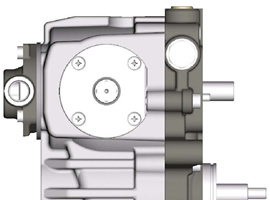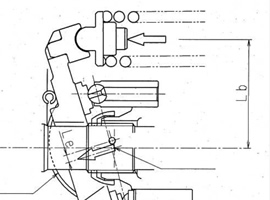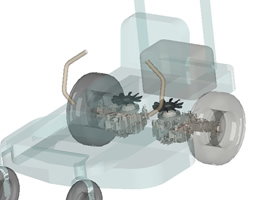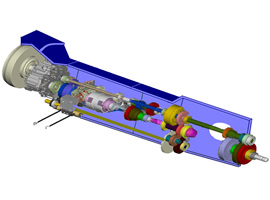- Top
- Technology
- Project History
- Four-Wheel Drive System to Minimize Turf Damage
Project History
Four-Wheel Drive System to Minimize Turf Damage
A lawn mower can actually damage your grass while you ride on it. The problem is caused by the inefficiency of a 2WD system, especially while turning. This motivated us to develop a 4WD vehicle with a hydraulic front wheeel drive unit (KXH series) that will leave your lawn damage-free.

Turning features
General 4WD vehicle: As the drive shaft mechanically couples the front and rear wheels, the speed ratio is fixed on both ends. When the vehicle is turning, it doesn't move smoothly because the wheel speed is held constant.


This is the hydraulic 4WD model.
The rear transmission has a pump and motor.
The front axle has 2 motors parallel to eachother.
Both the rear and front units contain pipes alined with each system.


The hydraulic front wheel drive (HFWD) unit is linked to the hydraulic actuator of the dual motors and steering wheel to proportionally increase the speed of the front wheels. This eliminates slipping while turning.

Therefore, the vehicle with HFWD can turn smoother and tighter than the standard mechanical 4WD.
Influence of the speed ratio on the front and rear axles
If the system was soley designed as "front speed > rear speed", the vehicle would waste a significant amount of power due to power circulation.

The pressure waveform (6-3) shows that the setting "front speed > rear speed" causes the reversal phenomenon (pressure B > A).
The pressure waveform (6-1) shows the range in which the vehicle can move safely.
If the vehicle setting is "front speed = rear speed", the pressure also balances (pressure B = A) (6-2).
That is limiting point without power circulation.
To conclude, the optimal setting in a 4WD system is "front speed =< rear speed" where the rear and front transmissions are coupled in a straight line.
Regarding the setting of the hydraulic front wheel driving unit, the speed can be changed by adjusting the swash plate degree. But, decreasing speed too much causes a negative pressure occurs.

The speed ratio between the front and rear axles changes easily because the radius equilibrium can be effected by uneven tire pressure, attachments, etc. To ensure a level vehicle, each vehicle should be adjusted precisely.
To improve negative pressure, the check valve is located on the circuit between the front axle and the rear transmission (7). The result is an adjustment zone that is larger than before, and productivity is raised.
Why we use a "no-drive shaft" system


With a drive shaft, the mowing deck has to be located in a low position on a small vehicle. Because the mowing deck is low to the ground, there is a higher likelihood of hitting something unintentionally while the vehicle is moving. The Hydraulic 4WD system solves this problem by not needing a drive shaft. The location of the hydraulic pipe allows for a much larger clearance, similar to that of a 2WD vehicle. Our customers also have the option to add this system to their 2WD vehicle to create a 4WD vehicle.
Postscript
In Europe, the demand is high for a reliable tractor that can take on the hilly landscape. Our rigid frame vehicle has already been well-received in this market and has a great travelling performance. We constantly strive to develop products that our customers love in order to help make their lives more comfortable and efficient.



